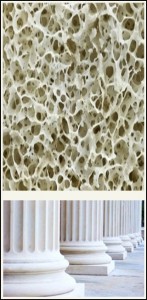Osteoporosis is a condition which increases a person’s risk of fracture and is a major health problem affecting millions of Americans. Osteoporosis literally means “porous bone” and is defined as significantly reduced bone mineral density (BMD). Fractures of the hip, wrist, shoulder, and spine are common sites in patients with this condition. These fractures can lead to hospitalization, decreased quality of life, and even death. “Osteopenia” refers to reduced bone density, but the degree of bone loss is not as severe as in osteoporosis.
What are the risk factors for osteoporosis?
 Osteoporosis is most common in post-menopausal women. Other risk factors include family history, Caucasian or Asian ancestry, poor nutrition, sedentary lifestyle, excessive alcohol intake, lack of sunlight exposure, and smoking. Some medications, including oral steroids, are related to bone loss. Kidney disease, metabolic disorders, and genetic syndromes are less common causes.
Osteoporosis is most common in post-menopausal women. Other risk factors include family history, Caucasian or Asian ancestry, poor nutrition, sedentary lifestyle, excessive alcohol intake, lack of sunlight exposure, and smoking. Some medications, including oral steroids, are related to bone loss. Kidney disease, metabolic disorders, and genetic syndromes are less common causes.
How do I know if I have osteoporosis?
BMD can be measured by a bone density test (DEXA scan) ordered by your primary care physician. BMD values have been shown to correlate with fracture risk. In other words, the bone density test is a reasonable predictor of whether a person will have a fracture in the future or not. Occasionally your primary care physician will order blood tests to evaluate the condition.
What can I do to prevent osteoporosis?
A person’s maximum bone density (peak bone mass) is obtained during his or her 20s and 30s. As people age beyond that point, we naturally lose bone mass. Building a strong foundation is the best way to prevent problems in the future. In order to obtain the best skeletal foundation, I encourage diets rich in protein and calcium, regular exercise, and avoiding tobacco products and excess alcohol. Most young adults need 1000-1200 mg of calcium per day which can be obtained from dairy products, such as cheese, yogurt, and milk, broccoli, beans, fish, and nuts or calcium supplements. A reasonable exercise program includes 20-30 minutes of weight-bearing activity at least 3 times per week. Weight bearing exercises include walking, jogging, hiking, biking, playing outdoor sports, and dancing. In addition to the musculoskeletal benefits, these types of exercises can also improve your overall cardiovascular and pulmonary health.
What can I do to treat osteoporosis?
 Osteoporosis is treatable! Once osteoporosis has been diagnosed by a physician, treatment is aimed at reducing fracture risk. Medications, such as bisphosphonates, are commonly prescribed to slow the progression of bone loss. There are multiple types of medications available, including a once-a-month pill and a once-a-year injection. These medications can help prevent future fractures, and many doctors recommend their use. Your primary care physician is best suited to discuss the balance between the risks and benefits of using osteoporosis medications. He or she can prescribe a medication if you are a good candidate.
Osteoporosis is treatable! Once osteoporosis has been diagnosed by a physician, treatment is aimed at reducing fracture risk. Medications, such as bisphosphonates, are commonly prescribed to slow the progression of bone loss. There are multiple types of medications available, including a once-a-month pill and a once-a-year injection. These medications can help prevent future fractures, and many doctors recommend their use. Your primary care physician is best suited to discuss the balance between the risks and benefits of using osteoporosis medications. He or she can prescribe a medication if you are a good candidate.
At any age you can improve your bone health with a few lifestyle changes. Regular, weight-bearing exercise 3-4 times per week is encouraged. Diets rich in protein and calcium and avoidance of tobacco products can help. Limiting alcohol to two drinks or less per day can also help. The National Osteoporosis Foundation recommends daily intake of 1200 mg of calcium and 800 units of Vitamin D for all people over 50. This can be obtained from food intake and/or supplements. Additionally, minimizing your fall risk is important to prevent injury and possible fracture. Simple changes such as securing loose rugs, adjusting prescription glasses, maximizing lighting in the house during the day, using a nightlight in the evening, placing a non-slip mat in the tub, and avoiding sedating medications can prevent falls.
You can also encourage your children, grandchildren, and young family members to eat a variety of nutritious foods, avoid tobacco products, and exercise outside regularly to build a strong foundation and reduce their fracture risk.
